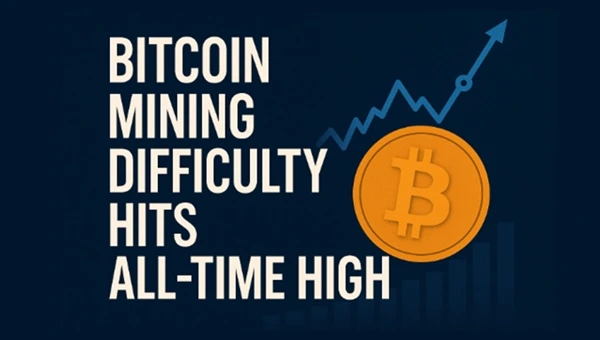

BTC Mining
Mining difficulty, which adjusts every 2,016 blocks (roughly every two weeks), calibrates how hard it is to solve the cryptographic puzzles that validate new Bitcoin blocks. The August adjustment was triggered by a sharp rise in hashrate, which soared to 933.61 exahashes per second (EH/s). This indicates a massive influx of computing power into the network, a sign that miners are doubling down on operational scale despite narrowing margins.
In 2025 alone, Bitcoin’s difficulty has increased by over 32% across nine upward adjustments, while five downward revisions accounted for a combined 16% average reduction. This volatility reflects a rapidly evolving mining ecosystem navigating tighter economics after the April 2024 halving, which reduced block rewards from 6.25 BTC to 3.125 BTC.

Despite this, Bitcoin’s price, hovering between $112,000 and $116,00 throughout July and early August, has encouraged miners to continue expanding operations with next-generation ASIC rigs and energy-efficient infrastructure.
The latest spike in difficulty has raised the stakes. Weaker miners are being priced out, while those with better infrastructure gain. Bitedge estimates July’s mining revenue at $1.66 billion, with daily earnings per EH/s climbing to $57,400, a modest 4% rise over June.
Public miners are scaling fast. CleanSpark’s hashrate stands at 45.6 EH/s. Marathon Digital, meanwhile, holds over 49,000 BTC, putting it among the top corporate holders globally. Their advantage: optimized hardware and access to cheap, green power.
For small-scale miners, the options are shrinking: consolidate or leave the game. With a Bitmain S21 XP, the cost to mine one BTC is around $55,000. That leaves little room for error as price swings and energy costs cut into margins.
Bitcoin Energy Use
Bitcoin’s energy use is back in focus as difficulty hits a new peak. But the story isn’t the same. Miners are moving toward renewables—solar, wind, and hydro—to cut costs and reduce risk. The shift is significant. Just a few years ago, critics warned of runaway energy consumption. Today, firms like SustainableBTC point to mining hubs in areas with excess power, where Bitcoin production helps balance the grid.
There’s a disconnect in Bitcoin’s market. Difficulty has never been higher, but activity on-chain is slowing. In May 2025, transaction fees made up just 1.3% of miner income, levels last seen two years ago, according to TheMinerMag.
That shift points to a deeper reliance on block rewards. It also highlights the changing face of demand. Institutions are piling in through ETFs and custodians, but those flows don’t always touch the blockchain.
Bitcoin’s stock-to-flow ratio now stands at 120, twice that of gold. With more than 94% of its total supply already mined, scarcity remains a key part of its value proposition. High mining difficulty reinforces this by securing the network and keeping issuance predictable.
A slight break may be coming. The next difficulty adjustment, expected around August 9, is projected to drop by 3%, bringing the level to roughly 123.7T. That would ease pressure on miners and shorten block times from 10 minutes 20 seconds back toward the target 10-minute average.
Yet the broader direction remains clear. Even modest drops are part of a longer-term climb that reflects network confidence and growing miner investment.
Historically, major difficulty jumps have mirrored key shifts in the crypto market. In 2023, the rise past 40T aligned with price recovery and NFT hype. Now, difficulty is three times higher. Nearly 30% of global hashrate is in the hands of public mining firms—evidence of growing consolidation.
But this growth may be hitting a ceiling. Bitedege expects 2025 to post Bitcoin’s slowest-ever difficulty rise. ASIC supply limits, grid constraints, and data centers shifting to AI workloads could all slow hashrate gains.
Final Word
Bitcoin’s network has never been more secure, but the outlook for miners is increasingly complex. Rising costs, shrinking rewards, and tighter competition are reshaping the industry. As the post-halving cycle settles, difficulty remains a key signal, one that reflects both network strength and operational pressure.
The upcoming adjustment may offer short-term relief. But the long-term trend is clear: mining has become a high-stakes, industrial-scale business. The bar for survival is only getting higher.
He has worked with several companies in the past including Economy Watch, and Milkroad. Finds writing for BitEdge highly satisfying as he gets an opportunity to share his knowledge with a broad community of gamblers.
Nationality
Kenyan
Lives In
Cape Town
University
Kenyatta University and USIU
Degree
Economics, Finance and Journalism


Facts Checked by Maryam Jinadu

 Fact checked by
Fact checked by 
 eabungana@gmail.com
eabungana@gmail.com 